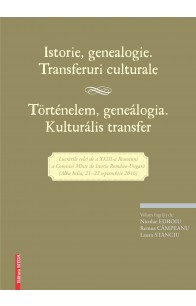Rezultate căutare pentru 'Iulia Elena Hossu'
„Cititorului, specializat sau nu, i se oferă o carte în care autorul a strâns şi a prezentat într-un mod compact, cu multe amănunte, uneori obositoare, dar necesare pentru arătarea adevărului istoric, tot ce a însemnat activitatea unui despărţământ al Asociaţiunii. Storcând fondurile arhivistice, coroborându-le cu publicaţiile periodice sau lucrările de istorie, am primit din partea autorului o lucrare bogată în informaţii care deschide şi alte posibilităţi de cercetare: istoricul altor despărţăminte ale Asociaţiunii, realizarea unui dicţionar al membrilor, în final, o sinteză complexă despre Asociaţiune, o instituţie care merită în continuare atenţia cercetătorilor.” Eva Mârza
Această carte a câștigat premiul Academiei Române „George Oprescu" în anul 2016
“[...] The research started from the premise that at least some of the wall paintings reflect the special social, political, and religious situation of the donors as knezes and Orthodox (Greek-rite) Christians in the Hungarian kingdom. Topics have been selected from the paintings of eight churches: the church of St. George in Streisângeorgiu (Hu. Sztrigyszentgyörgy), the church of the Dormition of the Virgin in Strei (Hu. Zeykfalva), the church of St. Nicholas in Densuș (Hu. Demsus), the church of St. Nicholas in Leșnic (Hu. Lesnyek/Lesnek), the Reformed church in Sântămăria Orlea (Hu. Őraljaboldogfalva), the church of the Dormition of the Virgin in Crișcior (Hu. Kristyor), the church of St. Nicholas in Ribița (Hu. Ribice), and the church of the Dormition of the Virgin in Hălmagiu (Hu. Nagyhalmágy). The churches were situated in two neighboring medieval counties – Hunyad, in the Transylvanian voivodate, and Zaránd – and the paintings date from the fourteenth and fifteenth centuries. The investigation is limited to Hunyad and Zaránd Counties, where the main body of medieval wall paintings in Orthodox churches has been preserved. In addition, the historical background of the donors is comparable in both regions. The pictorial subjects that have been selected for research are interpreted in relation to their social, political, and religious context. The study of the donor portraits, military saints, holy kings of Hungary, and the Exaltation of the Holy Cross focuses on their relevance for the social and political life of the knezes. The study of the paintings in the sanctuaries mainly sheds light on aspects of the religious life of the donors or local communities. The images are analyzed taking into account the use and meaning of their subjects in Eastern and Western, particularly Hungarian, painting, and the available information regarding their historical context. While indeed the pictorial message may be understood only through its historical background, the paintings themselves can also suggest new directions for research or favor a particular interpretation suggested by other types of sources.” from Introduction
SOMMAIRE
Alexander Baumgarten, Le reste comme problème de la philosophie
I. Figurer le reste
Luigi Tassoni, La poetica delle somiglianze. Milo De Angelis dalle rovine del soggetto alle tracce del riconoscimento
Corin Braga, Le centre structurel et ses restes
Giovanni Rotiroti, Per una poetica e una politica dei resti a partire da Urmuz: il caso di Tristan Tzara, Eugène Ionesco, Paul Celan e Gherasim Luca
Antonio Patraș, The Anecdote in The History of Romanian Literature from Its Origins to the Present
Ligia Tudurachi, « Jouets », « boîtes », « reliques ». Fascination du petit chez Hortensia Papadat-Bengescu
George Alexandru Condrache, The Residual Forms in Contemporary Central European Literature. Two Case Studies: Bohumil Hrabal and Ádám Bodor
II. Le continent de la non-lecture
Horea Poenar, Glitches of the Archive: On the Relation Between Memory and the Commons
Catherine Gravet, Dépouiller des archives pour éditer des textes « résiduels » : le cas Alexis Curvers
Florin Oprescu & Monica Oprescu, Mateiu Caragiale – Through the Leftovers’ Glass. From the Journal to Ephemerides
Gabriela Glăvan, Communist Leftovers: The Forgotten Books of Gellu Naum
Eugen Radu Wohl, Ion D. Sîrbu’s Anthumous Works as (Re)valuable Residues
Levente T. Szabó, Dilettantism as a Moral Panic. Recovering a Forgotten Discourse of Hungarian Literary Modernization]
Corina Croitoru, Le résidu du résidu : ombres de la poésie roumaine de guerre
Roxana Patraș, When All That Rests Is Literature: Traces, Transcriptions and Remnants of Great Speeches
Arina Neagu, Une autre approche sur les mémoires roumains de prison : le caractère résiduel de « l’indicible concentrationnaire »
Barbara Miceli, How to Turn a Forgotten Figure of American History into a National and Gender Emblem: Joyce Carol Oates’s Treatment of Mary Jo Kopechne in Black Water
III. Identités en marge
Marie Vrinat-Nikolov, Les langues ignorées de l’espace littéraire bulgare
Annalisa Cosentino, La boemia altrove
Marius Popa, Le classicisme français dans la critique littéraire de la génération roumaine de 1848. Radiographies d’un « malentendu »
Lavinia Sabou, The Travel Accounts We Don’t Write About. Eastern European Ways of Mapping the World
Ruxandra Cesereanu, Societal Metabolism and “Excretion”: Towards a Typology of Marginals (The Fiction of Venedikt Yerofeyev, Alexander Zinoviev and Roberto Bolaño)
IV. Survivances
Monica Fekete, La rigenerazione del poema cavalleresco: da centro epico-narrativo a margine del moderno, da trionfo idealistico a spazio del romanzo contemporaneo
Laura Marin, Survivances du neutre
Márta Zabán, Residual Nationalism. The Nineteenth-Century Hungarian Folk Drama as a Reinterpretation of European Theatrical Nationalism. Pour une politique du résiduel en littérature
Ioana Bot, Gli esordi dimenticati della stilistica: Leo Spitzer, censore dei soldati italiani nei campi di prigionia della Prima Guerra Mondiale
Elena Crașovan, (Mis)readings of Contemporary Magical-Realist Fiction in the Context of Romania’s 2000 Literary Generation. The Case of Bogdan Popescu
Adriana Stan, Monuments of Literature, Scraps of Criticism
V. Entretiens: Ioana Bot, What’s Left? A Discussion on the Remains of Writing – and the Remains of Living – with Two European Authors
Preț Normal: 150,00 LEI
Special Price 130,00 LEI







